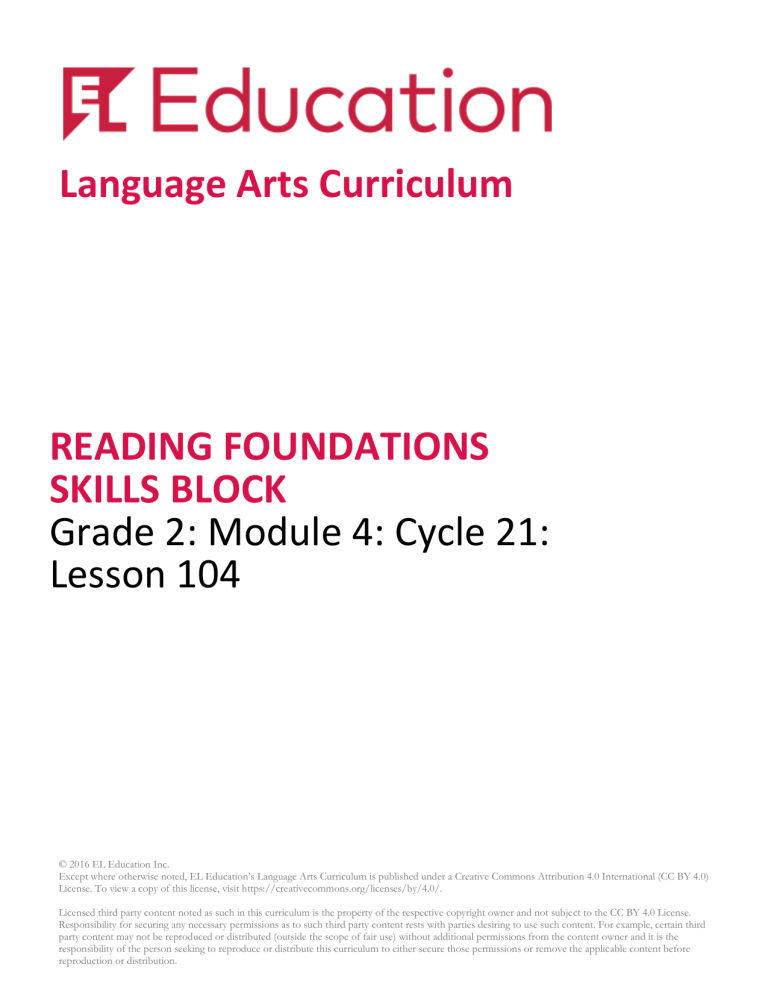
Language Arts Curriculum
READING FOUNDATIONS
SKILLS BLOCK
Grade 2: Module 4: Cycle 21:
Lesson 104
© 2016 EL Education Inc.
Except where otherwise noted, EL Education’s Language Arts Curriculum is published under a Creative Commons Attribution 4.0 International (CC BY 4.0)
License. To view a copy of this license, visit https://creativecommons.org/licenses/by/4.0/.
Licensed third party content noted as such in this curriculum is the property of the respective copyright owner and not subject to the CC BY 4.0 License.
Responsibility for securing any necessary permissions as to such third party content rests with parties desiring to use such content. For example, certain third
party content may not be reproduced or distributed (outside the scope of fair use) without additional permissions from the content owner and it is the
responsibility of the person seeking to reproduce or distribute this curriculum to either secure those permissions or remove the applicable content before
reproduction or distribution.
Reading Foundations Skills Block
Grade 2: Module 4: Cycle 21: Lesson 104
Enlarged Homophone Demonstration Sentence
Where is the red shirt that you
need to wear for the game?
| Language Arts Curriculum
2
Reading Foundations Skills Block
Grade 2: Module 4: Cycle 21: Lesson 104
Excerpt from Decodable Reader:
“The Life Cycle of Moths and Butterflies”
(pages 2–4)
Do you think butterflies and moths are animals or insects? You’re right!
Butterflies and moths are both insects.
Butterflies and moths are similar to each other. They both have wings
with pretty patterns. They can both fly. And they both have four stages
of life.
The first stage is the egg. A mother butterfly or moth lays an egg on a
leaf, on a stem, or on another object.
| Language Arts Curriculum
3
Reading Foundations Skills Block
Grade 2: Module 4: Cycle 21: Lesson 104
Fluency Rubric
I Can Read:
Smoothly
With
expression
With meaning
At just the
right speed
1
2
3
4
I regularly pause
while reading to
decode words (by
phonemes). I
frequently repeat
words and/or
short phrases
during reading.
My reading
sounds choppy
throughout the
text.
I often pause
while reading to
decode words. I
repeat some
words or short
phrases during
reading. My
reading sounds
choppy in a
majority of the
text.
I read mostly in
phrases and
occasionally
pause for
unfamiliar words.
My reading
generally sounds
even with some
interruption
when I encounter
challenging
sentence
structures.
I read in phrases
while selfcorrecting
unfamiliar words
and challenging
sentence
structures to
maintain
consistency in
smoothness.
My reading does
not sound like
natural talking. I
read in a
monotone voice
that does not
express
interpretation of
the text.
My reading
sounds like
natural talking in
some parts of the
text. I read in
some small
phrases that
rarely express
interpretation of
the text.
My reading
sounds like
natural talking
during most of
the text. I read in
longer phrases
that express
some
interpretation of
the text.
My reading
sounds like
natural
conversation
throughout the
text. I read in
phrases that
express accurate
interpretation of
the text.
During reading,
my inflection
does not reflect
punctuation in
the text. I rarely
read in
syntactically
meaningful
phrases.
I often read
without attention
to punctuation or
intonation. I read
in some
syntactically
meaningful
phrases.
I read with some
attention to
punctuation and
intonation to
support meaning.
Most of my
phrasing is
syntactically
meaningful.
I read with
attention to
punctuation,
intonation, and
stress to support
meaning. My
phrasing is
syntactically
meaningful.
My reading is
slow and labored
throughout the
text.
My reading is
mostly slow
throughout the
text.
My reading varies
from slow to fast
throughout the
text.
My reading is
consistently
appropriate
throughout the
text.
| Language Arts Curriculum
4
